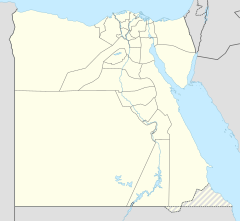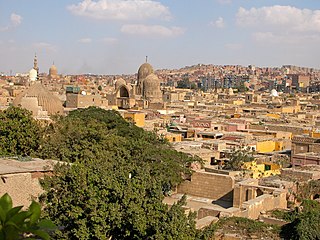
The City of the Dead, or Cairo Necropolis, also referred to as theQarafa, is a series of vast Islamic-era necropolises and cemeteries in Cairo, Egypt. They extend to the north and to the south of the Cairo Citadel, below the Mokattam Hills and outside the historic city walls, covering an area roughly 4 miles (6.4 km) long. They are included in the UNESCO World Heritage Site of "Historic Cairo".
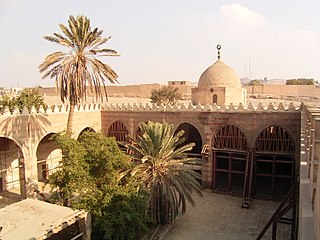
The Aqsunqur Mosque (Arabic: مسجد آق, Turkish: Aksungur Camii; also known as the Blue Mosque or the Mosque of Ibrahim Agha is located in Cairo, Egypt and is one of several "blue mosques" in the world. It is situated in the Tabbana Quarter in Islamic Cairo, between Bab Zuweila and the Citadel of Cairo. The Aqsunqur Mosque also serves as a funerary complex, containing the mausoleums of its founder Shams ad-Din Aqsunqur, his sons, a number of children of the Bahri Mamluk sultan an-Nasir Muhammad and that of its principal restorer, Ibrahim Agha al-Mustahfizan.

Al-Ashraf Sayf ad-Dīn Barsbāy was the ninth Burji Mamluk sultan of Egypt from AD 1422 to 1438. He was Circassian by birth and a former slave of the first Burji Sultan, Barquq.

The Qalawun complex is a massive pious complex in Cairo, Egypt, built by Sultan al-Mansur Qalawun from 1284 to 1285. It is located at Bayn al-Qasrayn on al-Mu'izz street and like many other pious complexes includes a hospital (bimaristan), a madrasa and mausoleum. Despite controversy surrounding its construction, this building is widely regarded as one of the major monuments of Islamic Cairo and of Mamluk architecture, notable for the size and scope of its contributions to legal scholarship and charitable operations as well as for the richness of its architecture.
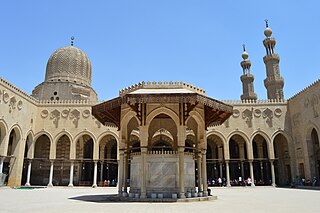
The Mosque of Sultan al-Mu'ayyad is a Mosque in Cairo, Egypt next to Bab Zuwayla built under the rule of sultan Al-Mu'ayyad Sayf ad-Din Shaykh from whom it takes its name, "Al-Mu'ayyad", meaning The Supporter in Arabic language. Construction began in 1415 and the mosque was completed in 1421. The complex included a Friday mosque and a madrasa for four madhhabs. It replaced a prison which originally stood next to Bab Zuwayla.

The cruciform Madrasah of the Amir Sarghatmish, built in 1356, lies to the northeast of the Mosque of Ibn Tulun, in Islamic Cairo. The building's school, mosque, and mausoleum can be seen from Ibn Tulun's spiral minaret, while its entrance is on Saliba Street. This structure includes a madrasa, mosque, and mausoleum. The madrasa is also referred to as the Mosque of Amir al-Sayf Sarghatmish.

The Tomb of Salar and Sangar al-Gawli is a historic funerary and religious complex located in Cairo, Egypt, on the plateau of Qal'at al-Kabsh. It contains the mausoleums of Sayf al-Din Salar and A'lam al-Din Sanjar al-Jawli, who were Mamluk emirs of the 14th century. Currently, the complex is abandoned.
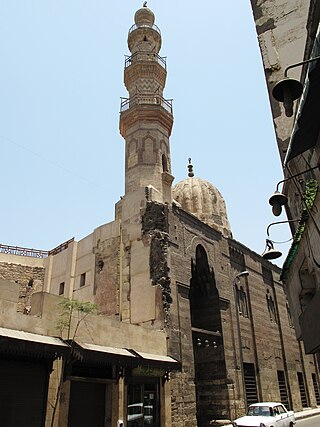
The Mosque and Khanqah of Shaykhu is an Islamic complex in Cairo built by the Grand Emir Sayf al-Din Shaykhu al-Nasiri. The mosque was built in 1349, while the khanqah was built in 1355. Shaykhu was the Grand Emir under the rule of Sultan an-Nasir Hasan.

The Sultan al-Ghuri Complex or Funerary complex of Sultan al-Ghuri, also known as al-Ghuriya, is a monumental Islamic religious and funerary complex built by the Mamluk sultan Qansuh al-Ghuri between 1503 and 1505 CE. The complex consists of two major buildings facing each other on al-Mu'izz li-Din Allah street, in the Fahhamin Quarter, in the middle of the historic part of Cairo, Egypt. The eastern side of the complex includes the Sultan's mausoleum, a khanqah, a sabil, and a kuttab, while the western side of the complex is a mosque and madrasa. Today the mosque-madrasa is still open as a mosque while the khanqah-mausoleum is open to visitors as a historic site.

Mamluk architecture was the architectural style that developed under the Mamluk Sultanate (1250–1517), which ruled over Egypt, the Levant, and the Hijaz from their capital, Cairo. Despite their often tumultuous internal politics, the Mamluk sultans were prolific patrons of architecture and contributed enormously to the fabric of historic Cairo. The Mamluk period, particularly in the 14th century, oversaw the peak of Cairo's power and prosperity. Their architecture also appears in cities such as Damascus, Jerusalem, Aleppo, Tripoli, and Medina.

The funerary complex of Sultan Qaytbay is an architectural complex built by the Mamluk sultan al-Ashraf Qaytbay in Cairo's Northern Cemetery. It was built between 1470 and 1474. The main building is a mosque attached to Qaytbay's mausoleum, while other parts of the complex include residential structures, a drinking trough for animals, and a smaller tomb. The complex is considered one of the most beautiful and accomplished monuments of late Mamluk architecture and it is pictured on the Egyptian one pound note.
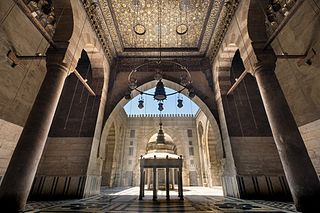
Mosque-Madrasa of Sultan Barquq or Mosque-Madrasa-Khanqah of Az-Zaher Barquq is a religious complex in Islamic Cairo, the historic medieval district of Cairo, Egypt. It was commissioned by Sultan al-Zahir Barquq as a school for religious education in the four Islamic schools of thought, composed of a mosque, madrasa, mausoleum and khanqah. The complex was constructed in 1384-1386 CE, with the dome added last. It was the first architectural facility built during the rule of the Circassian (Burji) dynasty of Mamluk Sultanate.

The Funerary Complex of Amir Taghribirdi or Mosque and Madrasa of Taghribirdi is a historical funerary complex of a mosque and madrasa located in Cairo, Egypt and built in the year 1440, during the Mamluk Sultanate. This monument honors Amir Taghribirdi, the mosque's commissioner and the secretary to Sultan al-Zahir Jaqmaq. The mosque and madrasa of Taghribirdi is located on a corner of Saliba street. This is not to be confused with a different Mosque of Taghribirdi, which is located in the Darb al-Maqasis neighborhood of Cairo.

The Al-Ashraf Mosque or the Mosque-Madrasa of Sultan al-Ashraf Barsbay is a historical complex of mosque and madrasa located in Cairo, Egypt. The mosque was built during the Mamluk period by the Burji Sultan Al-Ashraf Al-Barsbay. The complex consists of a mosque-madrasa, mausoleum, and Sufi lodgings. The mosque is characterized by its design, which incorporates marble and stained-glass windows.

The Mosque ofAmir Qijmas al-Ishaqi or Abu Hurayba Mosque is a late Mamluk-era mosque in Cairo, Egypt. It dates from 1480-81 CE and is located in the historic al-Darb al-Ahmar district, near Bab Zuweila. It is considered by many to be one of the finest examples of late Mamluk architecture.

The Khanqah of Faraj ibn Barquq is a religious Islamic funerary complex built by the Mamluk Sultan Faraj ibn Barquq from 1400 to 1411 CE. It is located in Cairo, Egypt, in the Northern Cemetery which is a part of Cairo's historic necropolis districts. It is considered one of the most accomplished works of Mamluk architecture and one of the major monuments of Cairo's Northern Cemetery district.

The Sultaniyya Mausoleum is a Mamluk-era funerary complex located in the Southern Cemetery of the Qarafa, the necropolis of Cairo, Egypt. It is believed to have been built in the 1350s and dedicated to the mother of Sultan Hasan. It is notable for its unique pair of stone domes.

The Mosque of Qaytbay, also known as the Madrasa of Qaytbay, is a historic religious structure in the Qal'at al-Kabsh neighbourhood of Cairo, Egypt. Completed in 1475, it is one of multiple monuments sponsored by the Mamluk sultan al-Ashraf Qaytbay. It is not to be confused with the more famous Funerary complex of Qaytbay in the Northern Cemetery. It is described as both a madrasa and a mosque by scholars, but functions as a mosque today.

The Mosque of Ulmas al-Hajib or funerary mosque of Amir Ulmas al-Hajib is a historic mosque and mausoleum in Cairo, Egypt. It was commissioned by a Mamluk official named Sayf al-Din Ulmas and its construction was completed in 1329–1330 CE.

